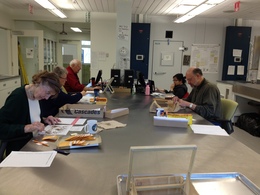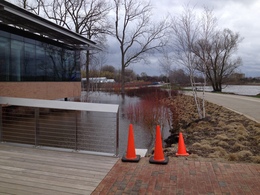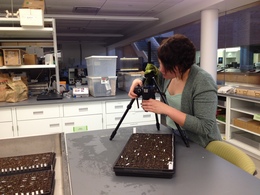My name is Jill Pastick and I have been interning in the Echinacea lab since early January. I am currently investigating the differences in growth between four hybrid crosses of Echinacea. Lately we are seeing some strange characteristics amongst the plants. Here are a few pictures of the plants at 21 days old. Can you spot the hybrids?

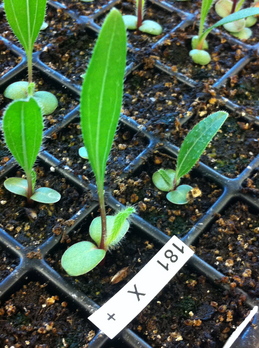
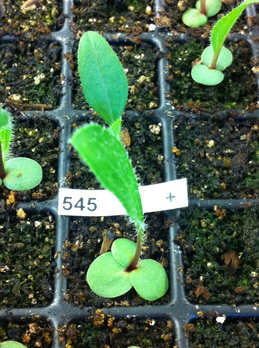
|
||||
|
The Thursday crowd is undertaking variety of tasks today: Bob (back left) is counting achenes using the new online data entry system, Char and Suzanne (left) are taking a random sample of achenes to weigh, Bill (front right) is extracting achenes from Echinacea heads, and Maria (back right) is working on her senior thesis on pollen limitation in a prairie grass. Gia (not shown) is identifying ants from the Staffenson prairie preserve. Hello! My name is Gia and I am one of the undergrads interning at the lab this quarter. I recently applied to the undergrad research expo that is held at Northwestern every year in May to try and present my findings about ant communities as part of the broader Echinacea project. Below is the abstract/ summary of my project that I sent in for the application. Katherine Muller, Stuart Wagenius Linking Prairie Ant Communities & Fire: The Effect of Fire on Ant Diversity in Prairie Remnants of Western Minnesota Research within the field of conservation emphasizes the maintenance of diversity. The Echinacea project focuses on the diversity of several prairie remnants in Western Minnesota, specifically upon a native plant living within these remnants called Echinacea angustifolia. For my project, I joined this long term effort by delving into some of the complexities surrounding the diversities of these prairie ecosystems. I evaluated the diversity of ant communities, which interact with an aphid species that feed exclusively on this plant, in remnants affected differently by fire. Historically, the presence of fire in long grass prairies has been positively correlated with the quality of the prairie by maintaining the dominance of grasses over woody plants. Specifically, I test the hypothesis that the ant communities differ between burned and unburned areas of native prairie remnants in Minnesota.I identified approximately a thousand ants, using dichotomous keys collected in 24 pit fall traps at two different sites on two separate dates during summer 2012, in order to evaluate the community composition and diversity. Preliminary analyses indicate that the diversity between recently burned and non-burned remnants was highly unique, with a disproportionately higher morphospecies count at one remnant, and with several morphospecies of Myrmica and Formica appearing exclusively in one location. This study shows that even by studying small organisms within an ecosystem, a great deal can be discerned about the health and diversity of the overall area and adds to out knowledge of the importance of fir in maintaining quality prairies throughout the Midwest. Due to the epic storm system pummeling the midwest, the Chicago area has experienced quite a bit of flooding over the past few days. The cute little lagoons dotting the Chicago Botanic Gardens have grown into murky lakes. Access to service roads is restricted by flooding. One upside to all the rain is that the Plant Science Center (home of our lab) has acquired a moat fine enough for any medieval fortress: Something about springtime makes you more aware of the layers of grime covering every surface of your life. Thankfully, volunteers Leslie and Anne agreed to help us battle the accumulated dust throughout lab. Believe it or not, this is a vacuum cleaner, not a ghost-busting device. Now that the lab is sparkling, clean, and free of ghosts, we can continue our scientific endeavors in a grime-free environment. Spring is a hectic time for most biota; interns are no exception. The lab currently has two undergraduate interns working on separate projects. Jill Pastick (Lakeforest College) is studying hybridization between native Echinacea angustifolia and non-native Echinacea pallida in Minnesota. This project began with Nicholas Goldsmith, who performed a hybrid crossing experiment in the summer of 2011 and observing pollination success based on style persistence. Shona Sanford continued his project by performing a second crossing experiment in the summer of 2012 and weighing achenes to determine whether or not they contained seeds. Jill is continuing the project by the germinating the achenes from Shona’s study to assess their survival and growth. She is currently photographing the seedlings to take detailed measurements on size and color. Our other intern, Gia Hallaman (Northwestern), returned to the lab this week after spending her spring break volunteering on an organic farm in Wisconsin. She is in the process of curating and identifying ants collected by Jill Gall in the summer of 2012. Jill’s collection covered 6 prairie remnants throughout Douglas County Minnesota. So far, Gia has identified a subset of ants from all 6 sites. For her project, she is going to focus her effort on the Staffenson prairie preserve in order to compare the ant community in the burned and unburned units. Hi everyone, I presented a poster at MEEC 2013 (which Katherine wrote on in the previous entry) and just got back from another poster presentation at Chicago Area Undergraduate Research Symposium (CAURS) today! Here’s my poster – enjoy looking at it to see what I found out from my summer fieldwork! Greg Diersen gave an oral presentation “Pollinator Collecting for the Lab and Classroom” at the Life Discovery – Doing Science Inaugural Education Conference on Mar 15-16 in St. Paul, Minnesota. As a science teacher participant in the Echinacea project through the National Science Foundation RET program, Greg developed a lesson plan for experimentally pan-trapping pollinators to use in secondary and post-secondary biology classes. This experiment offers diverse opportunities for doing science, learning biological concepts, and understanding about our changing world. Greg was a high-school science teacher for 16 years and is now a professor of biology at Martin Luther College in New Ulm, MN. diersegtATmlc-wels.edu |
||||
|
© 2024 The Echinacea Project - All Rights Reserved - Log in Powered by WordPress & Atahualpa |
||||

